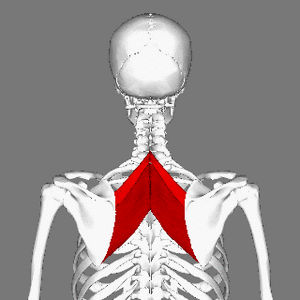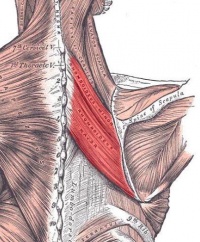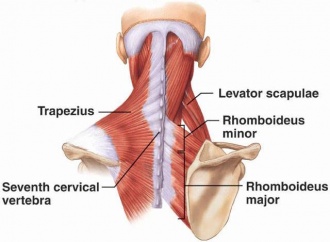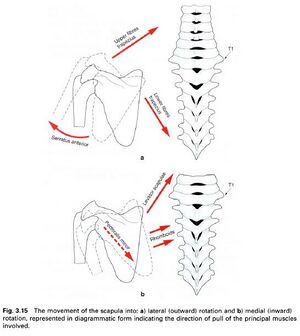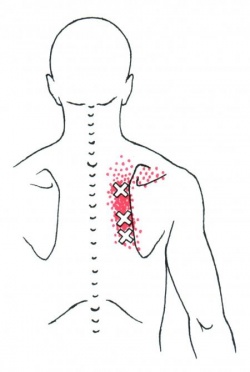Rhomboids
Original Editor - Naomi O'Reilly
Lead Editors - Naomi O'Reilly, Lucinda hampton, Ilona Malkauskaite, Kim Jackson, WikiSysop, Joao Costa and Kai A. Sigel
Description[edit | edit source]
The Rhomboids are two muscles - Rhomboid Major & Rhomboid Minor. The two rhomboids lie deep to trapezius to form parallel bands that pass inferolaterally from the vertebrae to the medial border of the scapula. Rhomboid Major is thin and flat and twice as wide as the thicker Rhomboid Minor which lies superior to it.
The rhomboids are important in upper limb movement and stability of both the shoulder girdle and scapula. Both rhomboids receive innervation from the dorsal scapular nerve and supplied by the dorsal scapular artery. Variants in rhomboid musculature have been found but are very rare. Winged scapula and rhomboid palsy are clinical pathologies associated with the rhomboids.[1]
Image 1: : Rhomboid muscles.
Anatomy[edit | edit source]
Origin & Insertion[edit | edit source]
The rhomboids consist of two separate muscles; the major and minor muscles which are found immediately deep to the trapezius.
The rhomboid minor is a cylindrical muscle that originates at the ligamentum nuchae and C7 and T1 vertebra. It inserts at the scapula's medial border near the base of the spine of the scapula.
The rhomboid major is quadrangular muscle located inferior to the rhomboid minor. The origin of the rhomboid muscles is from the spinous processes of the T2-T5 vertebra and inserts on the medial border of the scapula, just inferior to the rhomboid minor.[1]
|
Origin Proximal Attachment |
Insertion Distal Attachment | |
|---|---|---|
| Rhomboid Major | Spinous Processes T2-T5 | Medial Border of Scapula from Level of Spine to Inferior Angle |
| Rhomboid Minor | Nuchal Ligament Spinous Processes C7 & T1 |
Triangular Area Medial End of Scapular Spine |
| [2]
Rhomboid Major |
Nerve Supply[edit | edit source]
The motor function of the rhomboid muscles is controlled by the dorsal scapular nerve (DSN). The DSN originates from the ventral ramus of the spinal nerve root C5, and courses posterior inferiorly through the middle scalene muscles and between the posterior scalene, levator scapulae (to which it also provides innervation), and the serratus posterior superior. It continues deep to the brachial plexus to innervate both the rhomboid minor and major muscles at their anterior border[1]
Function[edit | edit source]
Actions[edit | edit source]
The rhomboids, with the assistance of many other muscles, help form the shoulder girdle. This group of muscles is important for movement of the upper extremity and stabilization of the shoulder through articulation with the trunk.
Functionally, the rhomboid muscles retract, elevate and rotate the scapula. They also protract the medial border of the scapula, keeping it in position at the posterior thoracic wall.
Dysfunction, weakness or loss of nerve function to the rhomboids causes winging of the medial border of the scapula and inferior scapular angle rotation.
The rhomboids are also vital to actions such as pulling and have been shown to play a large role in throwing and overhead arm movement[1].[3]
Strength Testing[edit | edit source]
Trigger Point Referral Pattern[edit | edit source]
The referral pattern of the Rhomboids is not as widely distributed but local to the muscles. The pain generally extends from the edge of the shoulder blades to the spine. Since the Rhomboids on both sides are almost always affected, this is a primary source of mid back tightness or aching between the shoulder blades.[5]
Techniques[edit | edit source]
Palpation[edit | edit source]
Palpated together. Covered by trapezius so need to relax trapezius by placing hand in small of back. Palpate along vertebral border by placing fingers under it. Have patient lift hand off back (with resistance if needed) and the rhomboids push fingers out.
Treatment[edit | edit source]
|
|
|
|
|
References[edit | edit source]
- ↑ 1.0 1.1 1.2 1.3 Farrell C, Kiel J. Anatomy, Back, Rhomboid Muscles. StatPearls [Internet]. 2021 Jul 26. Available:https://www.ncbi.nlm.nih.gov/books/NBK534856/ (accessed 1.1.2022)
- ↑ Anatomy Online Course. Rhomboid Major. Available from: https://www.youtube.com/watch?v=e_RvgWQj_DQ [last accessed 19/03/2015]
- ↑ http://brentbrookbush.com/rhomboids/
- ↑ Manual Muscle Testing Rhomboids. Available from: https://www.youtube.com/watch?v=4slWVLd4aj4
- ↑ http://www.pressurepointer.com/Rhomboid_trigger_points.htm
- ↑ Texas Massage Education. Rhomboids. Available from: https://www.youtube.com/watch?v=Rph0_lwn3DY [last accessed 27/05/2015]
- ↑ Texas Massage Education. Rhomboids. Available from: https://www.youtube.com/watch?v=Zqpgr3zn9uA [last accessed 27/05/2015]
- ↑ Massage Sloth.Massage Turorial: Rhomboids. Available from: https://www.youtube.com/watch?v=C9AvpcYNerg [last accessed 27/05/2015]
- ↑ eHowFitness. What Exercises Can Strengthen the Rhomboids?: Fitness Advice. https://www.youtube.com/watch?v=4jkbxsSamo8 [last accessed 27/05/2015]
- ↑ Myclinicspace. Shoulder Series - Rhomboid Strengthening https://www.youtube.com/watch?v=kTPSqazRgSQ [last accessed 27/05/2015]
- ↑ Green Chiropractic Clinic. How to stretch the Rhomboid Muscles. https://www.youtube.com/watch?v=aJOzZ3GRuJg [last accessed 27/05/2015]
- ↑ jjaimedc. Stretches: Mid-Back (Rhomboids). https://www.youtube.com/watch?v=DFhzvbDyQVQ [last accessed 27/05/2015]
- ↑ Nowcast. How to Foam Roll your Rhomboids. https://www.youtube.com/watch?v=VUXnptJLG4g [last accessed 27/05/2015]
- ↑ Robb Beams Foam Roller - Rhomboids. https://www.youtube.com/watch?v=zDrOnY_RSrY [last accessed 27/05/2015]
- ↑ John Gibbons. How to treat thoracic Back Pain and Rhomboids using Kinesiology Taping. https://www.youtube.com/watch?v=Jey-TYJRZAo [last accessed 27/05/2015]
